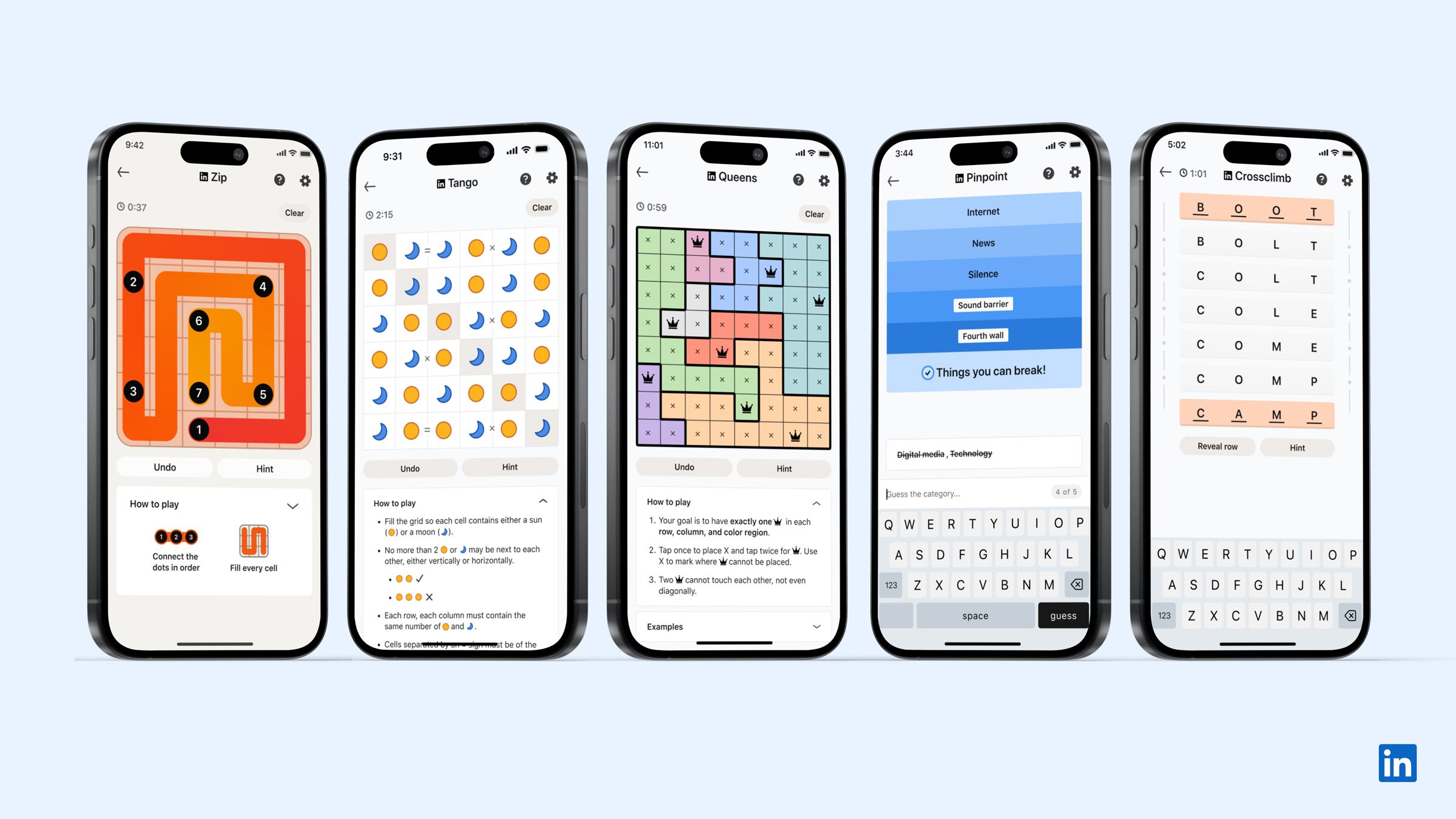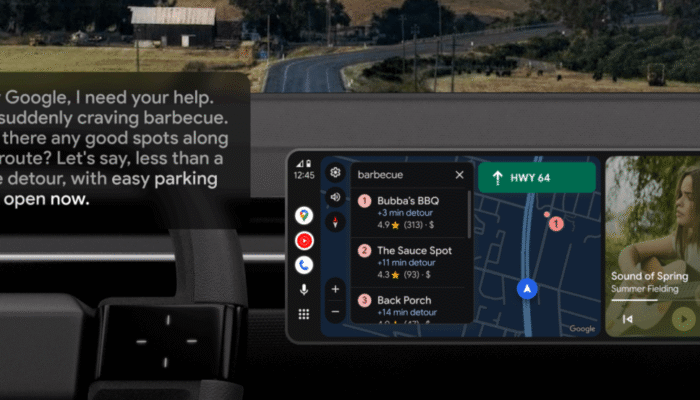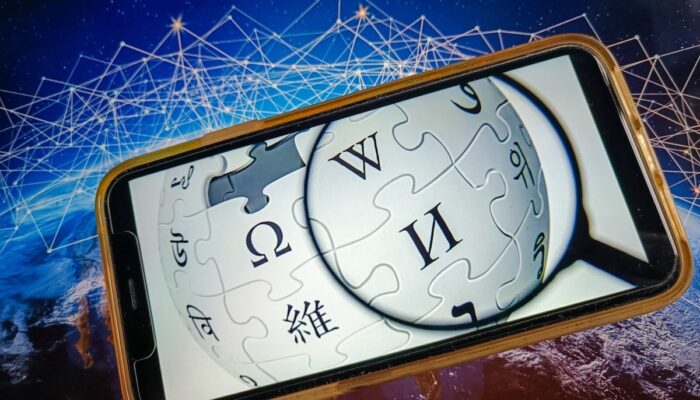It’s Friday night in the club and I’m on LinkedIn again. While all the cool kids in the crowd around me are grooving to the bouncy techno beats, I’m just fiddling with my phone.
I swipe open the work-focused social network, scroll through a sea of notifications that indicate which of my connections found which brand’s turgid post “insightful,” and finally spot what I’m looking for: Queens. It’s one of the little daily logic games available on LinkedIn. Today’s unique puzzle will reset at midnight, and if I don’t complete it by then, I’ll mess up my current streak of playing this game for nearly 100 days in a row. It is 11:56 pm and the band just launched into one of my favorite songs. But I’m locked in, tapping the Queens on my screen.
With all of the anxiety-inducing social services installed on my phone, I never expected stodgy old LinkedIn to be the one to give me FOMO. I’d never spent all that much time on the relatively anodyne site—even when job hunting—but one year ago today, LinkedIn introduced games to its platform, and I have never left.
The puzzles manifest in the form of simple brain teasers, some of them word based, some of them logic oriented. LinkedIn Games started with three puzzles—the chess-like Queens, the phrase guesser Pinpoint, and the Wordle-lite Crossclimb. Since then, it has slowly added additional puzzles, including the grid harmonizer Tango and most recently, the swipey maze game Zip.
“It’s a breather for me,” says Peter Rubin, head of publishing at Automattic and a former WIRED contributing editor who is also a self-described giant puzzle nerd. “They’reIt’s the perfect sort of bite-sized things. I don’t think about them before. I don’t think about them after. That’s it.”
You’re crushing it on Queens.
Courtesy of LinkedIn
When you complete a game, LinkedIn tells you your score, the average time it takes you to solve that game, and which of your connections have played. (I reached out to Rubin because LinkedIn told me he played nearly every day, just like me.) There isn’t a real ranking system, though if you do well enough, LinkedIn will congratulate you by saying you’ve done better than some percentage of CEOs on the platform.
“I just instantly got hooked,” says Tavonne Thomas, a photographer in London. “Listen, when it says you are smarter than a certain percent of the CEOs, I can’t help but feel good about myself that day.”
The move to add games was inspired by hits like Wordle and the absolute puzzle juggernaut that is the games division of The New York Times. A year ago at launch, I was skeptical and called LinkedIn’s efforts “a little bit of a ripoff” of Times games. Insiders wouldn’t totally disagree. Lakshman Somasundaram, who runs LinkedIn’s games division, video, and other internal efforts to boost site engagement the company calls “moonshots,” admits they did indeed take inspiration from the puzzle behemoths before them.
“A lot of credit to the Times,” Somasundaram says. “We are standing on the shoulders of giants at the Times who have done an incredible job.”
Then he pivots to head off my very obvious next question of why LinkedIn? Why put games on a website primarily meant for finding jobs, building a professional brand, and sometimes rolling your eyes at cringeworthy posts by out-of-touch business bros?
“I like to think of it as we are very much playing our own game,” Somasundaram says. “We want LinkedIn to feel like the world’s best workplaces. We need to find a way to bring that fun element onto our platform.”
Gamifying LinkedIn may conjure up flashbacks to early 2010s era Facebook, when the likes of FarmVille and Mafia Wars spread like a plague across all your weird uncle’s feeds. But the goal for LinkedIn’s games, Somasundaram says, is to be more precise. He wants games to be quick and simple to understand, but interesting enough to tease your brain, spark conversations, build connections, and, of course, entice you to stick around on LinkedIn a while longer. For some people (yes, me included) that has worked out quite well. For me and many others, the games have become more of a priority than the other services on LinkedIn.
“I was on there to look at cringe and to look at just what everybody was posting,” says Kelli Frye, an accountant and data analyst in Tennessee. “Then all of a sudden realized, oh, I’m just really interested in puzzles.”
Frye’s favorite games are Queens and Tango. She says that while she plays them every day, they haven’t led to much in the way of connections on the platform. Though people in her real life have certainly heard of them.
“I talk to friends about the puzzles, but they don’t do them,” Frye says “But they’re like, you’re very much obsessed and we love that for you.”
It takes one to Tango.
Courtesy of LinkedIn
Andrew Shaw, an engineer, had occasionally used LinkedIn to try to find a job, but soon became smitten with the games on the platform.
“I’ve been hooked ever since,” Shaw says via email. “I’ve never gone on LinkedIn so much as in the past six months. I feel like I have to play every morning. Often from the toilet at work. I want to keep up my win streak for all the games.”
Shaw is in so deep that he started a LinkedIn group called I’m Just Here For the Puzzle Games. At the time of this writing, there are 104 people in the group, but only three posts in the group’s newsfeed, including one by me asking whether anyone wanted to talk for this story. No one replied, but I should have known better because clearly the group lives up to its name.
“I figured there must be others like me,” Shaw says. “Not on LinkedIn to share some cringy hiring story or half-hearted comment on a sappy story. Or now strangely sharing political views! I’m just there for the puzzle games.”
In an era rich with generative tools that could be used to instantly create puzzles with a simple prompt, , LinkedIn’s games feel organic and human. That’s because none of the puzzles are computer or AI generated; every board is thought through and designed by a puzzle master. Crossword creator Paolo Pasco is LinkedIn’s games editor. Thomas Snyder, a puzzle creator and sudoku champion, helps craft logic puzzles like Queens and Zip.
In the comments of each game you’ll find dozens of people posting their scores using Wordle-style blocks of emoji. They also tend to discuss methodology for how best to tackle a puzzle, boost their scores, and better their time.
“The solver encounters a path while they’re solving that almost makes it like they’re having a conversation back with me,” the puzzle creator Snyder says. “I’ve left a trail of breadcrumbs in the forest and now they’ve followed it to find where the cabin is.”
The platform’s dedication to games doesn’t sit quite so well with some LinkedIn users.
Mitchell Tan, who runs a messaging service that he says was born out of hatred for LinkedIn’s inbox, finds the existence of LinkedIn’s games frustrating. He says he uses the platform to find and secure business connections who will then go on to buy services from him. But connecting and talking directly on LinkedIn feels more difficult to navigate than it should be, and to Tan, LinkedIn putting resources into efforts like games ignores people using the platform to make a living.
“LinkedIn is where you make money,” Tan says. “There’s a lot of leverage here. These people are not random teenagers on TikTok, they’re VPs of sales who make millions of dollars a year and they actually read your stuff if it’s good enough. You have really fancy CEOs and VCs posting all day, and so you have access to commercial influence. That’s why we’re here.”
As an example, he takes issue with games like Zip, which the user can play in a desktop browser using the arrow keys on their keyboard. But the arrow keys don’t work to navigate LinkedIn’s inbox, which he feels is a misuse of resources that prioritizes a more frivolous feature over the parts used by LinkedIn’s power users.
“What the heck is this $30 billion company doing?” Tan says, “We are literally making this platform valuable. In the world of people hustling and trying to build their business, the idea of coming to LinkedIn for entertainment is kind of odd.”
Despite asking several times, LinkedIn wouldn’t share any specific numbers about how many people engage in games on the platform, other than to say that 830,000 people have subscribed to its daily Games newsletter and that “84 percent of players return the next day after playing.” Does that mean games are a net boon to LinkedIn’s wider services? Maybe.
“A lot of real life is solving problems that may or may not have an answer,” Snyder says. “A puzzle is a pretty organized thing that should have an answer if you just get about doing it. Puzzles are a small way to get into thinking about life.”
“LinkedIn is one of the few social media outlets that doesn’t feel tainted to the point of unusability,” Rubin says. “Games don’t interrupt it or pollute the play experience with a lot of other things, with popups or trying to pull you to this part of the site. It’s a very easy thing to go into and get out five minutes later.”
“The work day is hard. Job hunting is harder,” says Thomas, the photographer. “So being able to take a break, but also do something you can achieve and finish quickly, is a good reward.”
Richard Liverman is a UK consultant who has built a following off his cheeky blog posts and curated Spotify playlists based around trying to solve LinkedIn’s category-guessing game Pinpoint. As a self-anointed “King of Pinpoint,” Liverman says engaging in a tongue-in-cheek bit based on LinkedIn’s games has led him to connections with upwards of 200 people on the site.
“LinkedIn is getting better, but it can be a little bit stuffy,” Liverman says. “You know what it’s like when you’re networking, you can tell people that are really trying and it’s just almost uncomfortable. So Pinpoint and all the games, I think it’s allowed people to network and communicate in a much more fun way.”




